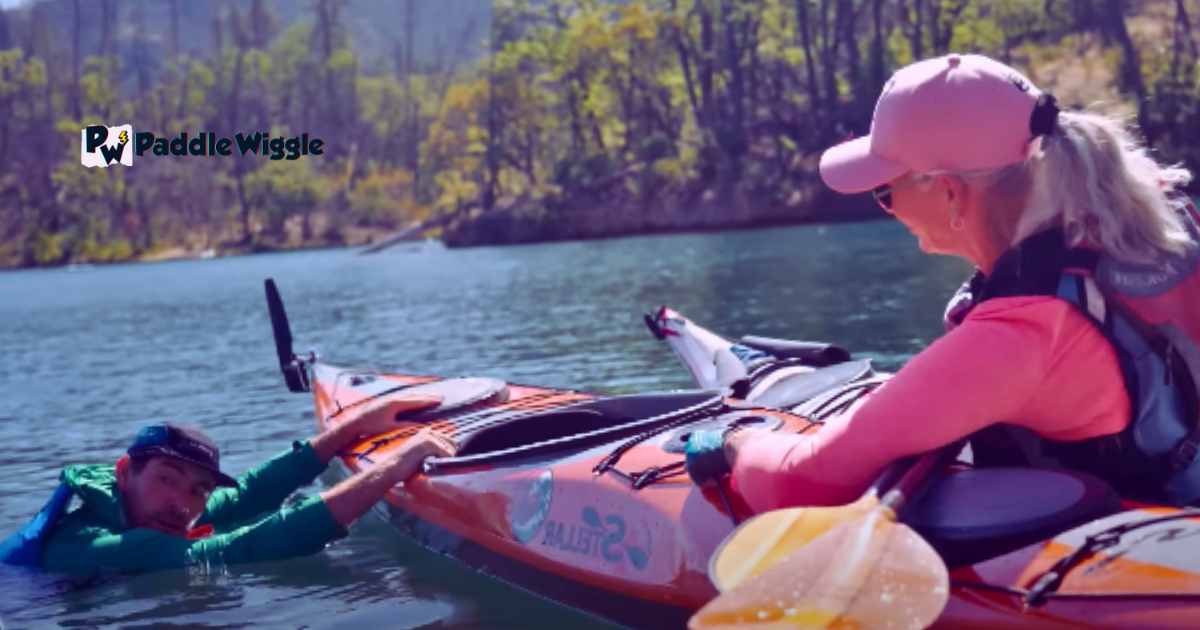Kayaking is often seen as an exhilarating water sport, but what about non-swimmers? Many people wonder if kayaking is safe for those who can’t swim well. So, is kayaking dangerous for non-swimmers? Yes, it can be risky if you don’t take safety seriously. But the good news is that with the right safety measures, kayaking can be safe and fun for non-swimmers.
In this guide, we’ll focus on kayaking for non-swimmers. We’ll give you tips and advice to make sure you have a safe and enjoyable time on the water. We’ll talk about safety concerns, what non-swimmers should know, and practical ways to help everyone, regardless of their swimming ability, enjoy kayaking safely.
Contents


Potential Risks Of Kayaking For Non-Swimmers
Kayaking is a thrilling adventure, but it’s essential to know about the possible risks, especially if you can’t swim. Kayaking is usually safe by itself, but not knowing how to swim can make being in the water a bit tricky and risky. Let’s take a closer look at why kayaking can be risky for non-swimmers.
Higher Risk of Accidents or Drowning
People who can’t swim are more likely to have accidents or drown when kayaking than those who can swim well. If unexpected things happen, like strong currents or sudden weather changes, non-swimmers might need help to handle these challenges. Without the ability to swim, they may find it difficult to stay afloat or make their way back to safety.
Capsizing and Falling into Water
For people who can’t swim, one big worry when kayaking is the chance of the kayak tipping over and ending up in the water. But if you’re a good swimmer, this might not be as scary because you know how to swim back to your kayak or to the shore. However, for non-swimmers, this can be extremely dangerous and panic-inducing.
Limited Self-Rescue Options


Lack of swimming ability significantly limits self-rescue options in emergency situations. When faced with unexpected swims due to capsizing or falling into the water, non-swimmers may struggle to keep themselves above water and find it challenging to get back into their kayak without assistance. This lack of self-rescue options increases vulnerability in potentially hazardous situations.
To ensure safety while kayaking as a non-swimmer, there are several precautions you can take:
- Wear a Personal Flotation Device (PFD): Make sure to wear a properly fitting life jacket that’s approved by the authorities. It will help you float and improve your odds of staying on the water’s surface if you end up in it by surprise.
- Stay Close to the Shore: Stay in quiet and shallow waters close to the shore so you can quickly get to safety if something goes wrong.
- Kayak with a Buddy: Whenever possible, kayak with someone who is a proficient swimmer. They can provide assistance if needed and ensure your safety.
- Take Lessons or Training: Think about taking swimming or kayaking classes meant for people who can’t swim. These classes teach you essential swimming skills and how to rescue yourself, which will make you safer when you’re on the water.
Keep in mind, even if you follow these safety tips, it’s important to be careful and choose wisely when and where to go kayaking if you can’t swim. Always assess water conditions weather forecasts, and follow local regulations to minimize risks.
Kayaking Tips for Non-Swimmers


Kayaking can be a fun water sport, but if you can’t swim, you might worry about staying safe in the water. Don’t worry! With some precautions and the right approach, kayaking can still be a fun and enjoyable experience for beginners. Here are some tips to help non-swimmers have a safe and enjoyable time kayaking:
Wear a Properly Fitted Life Jacket
Safety should always be your top priority. As a non-swimmer, it is crucial to wear a properly fitted life jacket at all times while kayaking. Wearing a life jacket will help you float in the water and give you extra protection if something goes wrong. Make sure the life jacket fits snugly and comfortably, allowing you to move your arms freely.
Stay Close to the Shore or Calm Waters
If you’re new to kayaking and not good at swimming, it’s important to begin in peaceful waters or stay near the shore. This way, you’ll feel more secure knowing that you can easily reach safety if needed. Only go into rough or wavy waters once you become a more experienced and confident kayaker.
Paddle with an Experienced Partner
Having an experienced partner by your side can provide additional safety and support during your kayaking adventure. Look for fellow kayakers who are experienced and comfortable in the water. They can teach you various skills, help you if necessary, and make sure you stay safe during your kayaking adventure.
Take Kayaking Lessons
Consider taking kayaking lessons specifically designed for beginners or non-swimmers. In these lessons, you’ll learn important ways to paddle, steer your kayak, and stay safe in the water. Getting taught by experts will make you feel confident and well-prepared for safe and enjoyable kayaking trips.
Choose Recreational Kayaks
When starting out as a non-swimmer, it’s recommended to opt for recreational kayaks. These kayaks are stable, easy to maneuver, and designed for beginners. They make your time on the water safer and more comfortable. You can have fun kayaking without stressing about staying balanced.
Learn Basic Water Safety Skills
You don’t have to be a swimmer to go kayaking, but it’s good to know some basic water safety skills. Think about taking swimming lessons to get more comfortable in the water and to learn important things like how to tread water or float. These skills can come in handy if you accidentally capsize or find yourself in deep water.
Remember, even though kayaking can be safe for non-swimmers with proper precautions, it’s always a good idea to go with an experienced kayaker or paddle in groups. This way, you’ll have extra support and assistance if needed. So grab your paddle and life jacket, follow these tips, and get ready for an exciting kayaking adventure!
Reaching Your Kayak: Techniques without Swimming Skills
For those who don’t possess swimming skills, reaching your kayak can seem like a daunting task. However, using the right methods and plans, you can get back into your kayak safely and quickly without needing to be a good swimmer.
Now, let’s look at some ways you can use to get to your kayak. This will make sure that even if you can’t swim, you can still have fun kayaking without any problems.
Entering and Exiting Safely
If you can’t swim but want to have fun kayaking, there are safe ways to get in and out of your kayak without needing to swim. One option is to find a dock, ramp, or shallow area where you can easily access the water. This provides a stable surface for you to step into the kayak without having to swim.
Utilizing Assistance from Others
Another technique is to seek assistance from others who can help you get in and out of the kayak. They can provide support and guidance as you maneuver yourself into the boat. Having someone by your side can give you an extra sense of security, especially if you need more confidence in your swimming abilities.
Specialized Equipment for Easy Access
You can also use special gear like step stools or kayak launch systems to make it easier to get in and out of your kayak. Step stools give you a high spot to step into the kayak from the shore or a dock. Kayak launch systems are made for people who may have trouble moving or swimming and offer a safe and easy way to get in and out of the kayak.
When you’re using special gear, make sure to read and follow the instructions from the manufacturer, and be sure it’s right for what you need. It’s also a good idea to wear a life vest when you’re getting in or out of the kayak for extra safety.
Importance of Shallow Water
Choosing locations with shallow water is crucial when kayaking without strong swimming skills. Opting for calm, flat waters near the shore reduces the risk of capsizing or encountering rough conditions that may pose challenges for non-swimmers.
By staying close to shore in shallow water, non-swimmers have easy access back to land if needed. It’s always wise to familiarize yourself with rescue techniques beforehand so that you feel prepared in case of any emergencies.
Remember that even if you’re not a strong swimmer, wearing a life vest is essential for your safety. A life vest will keep you buoyant and provide added security while on the water.
Final Words
To sum it up, kayaking is an exciting sport that even non-swimmers can enjoy. But it’s essential to be aware of both the risks and rewards, especially for non-swimmers. While kayaking does carry some inherent dangers, it is not necessarily dangerous for non-swimmers as long as certain precautions are taken.
For a safe and enjoyable kayaking experience for non-swimmers, we recommend you take lessons or join guided tours led by experienced instructors.



